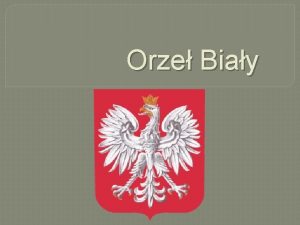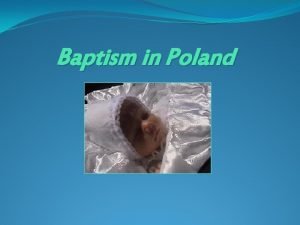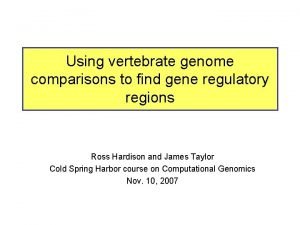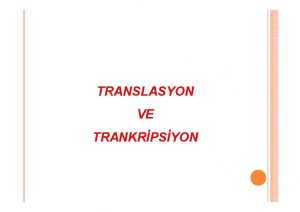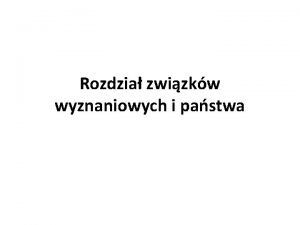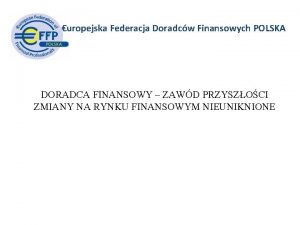Opening conference in Polan Project promoter Federacja Zwizkw




















- Slides: 20

Opening conference in Polan Project promoter: Federacja Związków Zawodowych Pracowników Ochrony Zdrowia i Pomocy Społecznej Project in partnership with Norway: Fagforbundet Duration: 01. 05. 2020 - 31. 10. 2021 POLAND Warsaw, 10 August 2020

Project challenges DECENT WORK – background of action The role of social dialogue introducing sustainable forms of social dialogue on decent work issues at regional, local level for all occupational groups in the health care sector Decision-making mechanisms to establish decision-making mechanisms for improving the decent work agenda in order to improve service quality The role of trade unions / social partners sharing experience and improving the competences of the social partners in order to facilitate social dialogue on decent work issues

Decent work The term decent work was created by the International Labour Organisation. DECENT WORK is employment which „(…) respects fundamental human rights, as well as the rights of worker in terms of safety of work and payment, respect for the physical and mental integrity of the employee while performing his or her employment”. Decent work concerns both the formal and the informal sector. It should apply to all types of work, people and families. According to the International Labour Organisation (ILO) „(…) decent work involves opportunities for work that is productive and delivers a fair income, security in the workplace and social protection for families, better prospects for personal development and social integration, freedom for people to express their concerns, organize and participate in the decisions that affect their lives and equality of opportunity and treatment for all women and men”.

Decent work The ILO's Decent Work Agenda represents a balanced and integrated programmatic approach to achieving the objectives of full and productive employment and decent work for all at global, regional, national, sectoral and local levels. It has four pillars: labour standards and rights, job creation and business development, social protection and social dialogue. 7 October is World Day for Decent Work

Poland - a few facts… The population of Poland – 38, 383 thousand Including women - 19, 816 thousand (women per 100 thousand men – 107) Area of the country – 31, 271 thousand ha Professionally active – 17, 019 thousand Average monthly remuneration in total gross national economy/2019 4, 918. 17 PLN public sector 5, 525. 91 PLN private sector 4, 773. 88 PLN

Polish health care system - some aspects Organisation of the health system The health insurance system in Poland is based on the principle of of social solidarity. The right to health protection and equal access to health care services financed from public funds, regardless of the economic condition of citizens is guaranteed by the Constitution of the Republic of Poland of 1997. The treatment of persons other than the insured, who have the right to health care services financed from public funds, is financed from the state budget. The health insurance contribution is calculated in proportion to the amount of the insured person's earnings - it is monthly and indivisible, it amounts to 9% of the contribution assessment basis. In the health care system, they perform management, financing, supervision and control functions: Ministry of Health, National Health Fund, Patient Ombudsman, budget and local governments.

Polish health care system - some aspects Medicinal entities entrepreneurs within the meaning of the Act on freedom of economic activity - independent public health care institutions, budget units, research institutes, doctors and nurses conducting medical activity in the form of individual or group professional practices Types of medicinal entities in-patient and 24 -hour hospital In 2019 there were 949 general hospitals (47, 3 beds per 10 thousand). Average patient's stay in hospital 5. 3 days in-patient and 24 -hour, other than residential (e. g. care and treatment facilities, nursing and care facilities, medical rehabilitation facilities, hospices) outpatient clinics (clinics, health centres, laboratories, diagnostic facilities) In 2019, there were 21, 881 clinics in operation in total Public pharmacies – 12, 889

Polish health care system - financing Health care payers and level of financing National Health Fund, local government institutions, state budget, private insurance, private households In 2020 the costs of health services in the National Health Fund 93. 1 billion PLN hospital treatment 49. 8 billion PLN basic health care 12. 5 billion PLN reimbursement of medicines 8. 9 billion PLN According to the National Health Account (2016) public expenditure – 71 % in total private expenditure – 29 % of which direct household expenses – 22. 9%

POLSKI SYSTEM OCHRONY ZDROWIA – WYBRANE ASPEKTY Płatnicy w ochronie zdrowia i poziom finansowania Narodowy Fundusz Zdrowia, instytucje samorządowe, budżet państwa, ubezpieczenia prywatne, gospodarstwa domowe W 2020 r. planowane koszty świadczeń zdrowotnych w Narodowym Funduszu Zdrowia to 93, 1 mld zł (głównie na lecznictwo szpitalne (49, 8 mld), podstawową opiekę zdrowotną (12, 5 mld zł) oraz refundację leków (8, 9 mld zł). Według Narodowego Rachunku Zdrowia (2016 r. ) wydatki publiczne – 71 % wydatków ogółem wydatki prywatne – 29 %, w tym bezpośrednie wydatki gospodarstw domowych – 22, 9%

Polish health care system - financing The current legislation assumes that in 2024 for health protection a minimum of 6% of GDP will be allocated: 5. 03 % of GDP in 2020. 5. 30 % of GDP in 2021. 5. 50 % of GDP in 2022. 5. 80 % of GDP in 2023. Healthcare expenditure as a percentage of GDP comparison for 28 European Union countries according to the World Health Organisation (WHO) for 2017 Sweden - 9. 22% of GDP / Germany 8. 73% of GDP / France - 8. 72% of GDP Cyprus - 2. 83% of GDP / Latvia - 3. 40% of GDP / Romania - 4. 05% of GDP / Poland 6 th last position from the end 4. 51% of GDP according to OECD for 2017 – 2018 Poland is ranked 5 th from the end with 4. 5% of GDP Cyprus 2. 8% GDP / Latvia 3. 4% GDP / Romania 4. 1% GDP / Bulgaria 4. 2% GDP France 9. 3% of GDP / Sweden 9. 3% of GDP Germany 9. 5% of GDP according to Eurostat for 2019 Cyprus 2. 86% GDP / Latvia 3. 47% GDP / Romania 3. 91% GDP/ Poland 4. 55% GDP Sweden 9. 15% GDP / Germany 9. 37% GDP / France 9. 53% GDP

Health expenditure per capita comparison of selected 28 European Union countries according to the World Health Organisation (WHO) for 2017 average 625 USD Poland in 4 th place from the end Bulgaria (USD 344), Romania (USD 436) Sweden (USD 4942), Luxembourg (USD 4907), Denmark (USD 4874) according to Eurostat for 2017 Poland in 4 th place since the end of 510. 6 euro Bulgaria (282. 07 euro), Romania (338. 28 euro) Latvia (443. 64 euro) Sweden (4, 272. 34 euro), Denmark (4, 217. 90 euro) and Luxembourg (4, 208. 42 euro)

Healthcare workers Groups of professions in health care having representation in professional self-governments doctors / dentists, nurses and midwives, laboratory diagnosticians, pharmacists, from 2015. - physiotherapists and other professions working in the health care sector Employment of health care workers Forms of employment: Employment contracts (fixed-term and permanent contracts, appointment) civil law contracts (contracts also with the self-employed) residency (for postgraduate medical students) The form of employment has an impact on salary Specific wages are defined in the company's payroll regulations The remuneration of trainees and residents is financed from the state budget

Healthcare workers - statistics Doctors – 136, 526 per 100 thousand population - 339. 8 / including 75 647 women and 54 879 men / average 49. 49 years at retirement age - 24% / average number of jobs - 1. 89 Dental doctors - 34, 768 per 100 thousand population - 90. 5 / including 25 958 women and 8 810 men / average - 46. 1 years at retirement age - 17% / average number of jobs - 1. 3 Nurses – 235, 569 per 100 thousand population - 613. 3 / average - 49, 5 years / retirement age - 17% average number of jobs - 1. 6 Midwives – 31, 185 per 100 thousand population - 81. 2 / average - 43. 3 years / retirement age - 15% average number of jobs – 1, 7 Physiotherapists – 66, 250 per 100 thousand of the population - 172 / average - 36. 9 / retirement age - 4%

Chosen employee matters Legal protection of labour The most common irregularities in providers of benefits such as: out-patient and in-patient and non-hospital health services - concerned: work regulations (62%), incorrect information about employment conditions (52%), overtime pay (37%), correctness of employment contracts (44%), granting holiday leave (53%), daily and weekly working time standard (31% and 26%), remuneration regulations (35%), payment of minimum pay for work (35%) The main groups of problems in the medical entities: • abuse of civil law contracts, i. e. the possibility to work in the same therapeutic entity on the basis of different legal relations, without maintaining the right to rest • working time • wage differences between different occupational groups • increasing workload in hospitals and medical facilities • the absence of sectoral collective agreements which could result in a significant improvement in working conditions in the sector

Chosen employee matters infringements Working conditions and safety in the health sector Infringements of health protection regulations refer to: periodic training (52%), identification of all work-related hazards (45%), equipment with work clothes and shoes (51%), documented occupational risk assessment (37%), initial training (workplace instruction) (25%), periodic medical examinations (37%), equipment with personal protective equipment (29%), tests and measurements of factors harmful to health at work (42%), preliminary medical examination (18%), no longer determine the cause of sharps injuries (30%)

The most important health worker problems – a European perspective The main problems reported by trade unions and which are the most urgent problems are: failure by employers to comply with the Labour Code with regard to the right of employees to rest, planning and taking their annual leave due to imprecise regulation imprecise interpretations of labour / time law regarding the establishment of work schedules (for shift workers) lack of specific regulation of the reference to the improvement of professional qualifications

The role of trade unions Polish and sectorial perspective Trade unions in social dialogue and decision-making National level Represented by the SOCIAL DIALOGUE COUNCIL (workers' (3) and employers' (5) representative organisations). In the regions, the regional dialogue - carried out and addressing the problems of the region, carried out by Voivodship Social Dialogue Councils. The Federation of Trade Unions of Healthcare and Social Welfare Employees as a member of OPZZ is represented in the Social Dialogue Council, problem teams and industry teams. Company level The most common form of bilateral dialogue in Poland is conducted at the company level between trade unions and the employer. The main instrument is negotiation (in individual and collective cases)

The role of trade unions Polish and sectorial perspective Trade unions in social dialogue and decision-making Industry level: Includes a specific sector of the national economy. In Poland, in many sectors (including health care), there is no partner on the part of employers to conclude e. g. an inter-company collective bargaining agreement – hence the sectoral dialogue is limited In health care – the dialogue is represented by trade unions from a variety of medical professions or uniform trade union organisations representing a particular profession.

Some aspects of social dialogue in Poland Forms of dialogue: Negotiations usually involve the social partners. At national level, a third party government is also involved. The aim of the negotiations is to reach a compromise that will guarantee social peace. Consultation - involves the same participants as the negotiation, but does not necessarily lead to an agreement, although the parties usually honour the outcome. Opinions - representatives of the state administration take the initiative to learn the opinions of trade unions and employers' organizations about government policy. The positions of the social partners are not absolutely binding on the government. The rules for giving opinions are regulated by law (the Trade Unions Act), which also specify on which matters the government is obliged to consult. Information - the social partners have the right to information on matters relevant to employees or employers.

 Prokaryotes vs eukaryotes venn diagram
Prokaryotes vs eukaryotes venn diagram Polan
Polan Batism of poland
Batism of poland Federacja bibliotek cyfrowych
Federacja bibliotek cyfrowych Erlanger v new sombrero phosphate co
Erlanger v new sombrero phosphate co Tugas promoter
Tugas promoter Exon intron promoter
Exon intron promoter Enhancer vs promoter
Enhancer vs promoter Promoter is a person who *
Promoter is a person who * Lac promoter
Lac promoter Enhancer promoter
Enhancer promoter Transkripsiyon nedir
Transkripsiyon nedir Initiator promoter
Initiator promoter Enhancer promoter
Enhancer promoter Wbs for restaurant project
Wbs for restaurant project The role of project management in achieving project success
The role of project management in achieving project success Background of the project proposal
Background of the project proposal Modern project profiles in spm
Modern project profiles in spm Project cost-duration graph
Project cost-duration graph Introduction to project management kathy schwalbe
Introduction to project management kathy schwalbe Project evaluation in software project management
Project evaluation in software project management

